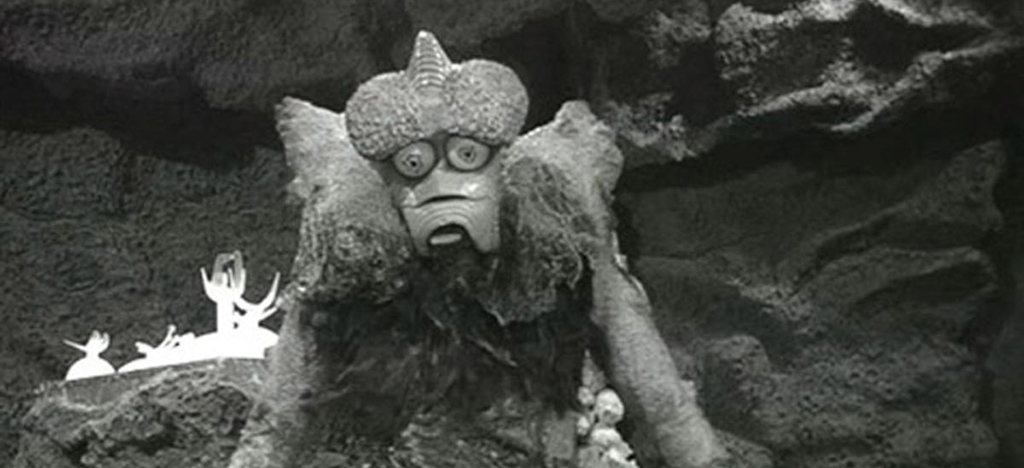
The Phantom Planet (William Marshall, 1961, 82 min.)
In the year 1980, Pegasus rockets launched from the moon have been disappearing, so the US Government sends a crack team headed by Captain Frank Chapman (Dean Fredericks) to investigate. After a meteor shower (or is it?) disables his ship and kills his copilot, he crash-lands on the titular phantom planet, actually an asteroid that can flit through space and time. Upon breathing the asteroid’s atmosphere, he shrinks down to HO scale and finds himself the prisoner of the little people who live there.
Their leader, Sessom (Francis X. Bushman), is happy to explain. They’ve created a top-secret acceleration device of some sort—much of the film’s dialog is expended on attempts to explain what, exactly, it is—that gives them the power to move their planet around. But in the wrong hands, it could be used for evil, so although strangers are welcome to become part of the society and even get their choice of hot chicks to shack up with, they’re not allowed to leave. Also, there’s a race of evil lizard people called the Solarites who really want the technology; Sessom and co. are holding one of them prisoner behind a force shield, and what could go wrong with that?
This film has been featured on Mystery Science Theater 3000 and countless other bad-movie late-night TV shows; one internet reviewer commented on the host, a “fat dude in a werewolf mask,” making farting sounds throughout the film. Look, it’s not Citizen Kane. There’s only two or three sets, and some of the acting is wooden (especially Al Jarvis as the judge of the odd court that decides Chapman’s fate when he arrives). But if you look at it in terms of what it’s trying to achieve, it’s actually quite compelling: a little cheaper-looking than average, but perhaps a little smarter. And despite having approximately a buck fifty to spend on effects, special effects whizzes Charles Duncan and Louis DeWitt deserved Oscars for their astounding miniatures and photographic effects, which outclass most big-budget films of the time.
The cast includes a couple of famous or would-be famous actors in the twilight of their careers. The stunningly beautiful Coleen Gray, who seemed poised for superstardom after early-career performances in Red River, Nightmare Alley, and Kiss of Death, only to have her contract dropped by Fox, still managed to make a few notable noirs like Phil Karlson’s Kansas City Confidential and Stanley Kubrick’s The Killing. She seems a little shell-shocked here, perhaps wondering what happened to her career, still statuesque but distracted. Although the handsome Herron (Anthony Dexter) wants her, she sets her dreamy eyes on the newcomer, although her apparent glee in informing him that he can never escape doesn’t exactly win him over. She’s upstaged by the mute Zetha (Dolores Faith), whose smoldering screen presence lasts as long as she remains mute, and is certainly aided when she writhes around on her marble bed.
And the “King of Movies” himself, Francis X. Bushman, plays Sessom, the leader of this tiny civilization. He’s the focus of the film, and he brings every ounce of his gravitas, drawing on what must have been crushing disappointment with a late career that he never envisioned to make Sessom feel almost Shakespearean in his dignity and pathos. He’s the tiny king who has control over a force that could transform the universe, only he must live as a vagabond to guard it from people who would misuse it, and meanwhile it’s slowly destroying him and his people. And there are other surprising moments, like the genuine drama when Chapman’s copilot is killed. Of course that complexity is presented in a bargain-basement setting, one whose limited budget encourages modern viewers—and probably contemporary viewers as well—to ignore its successes in favor of cackling unmercifully at its failures.

